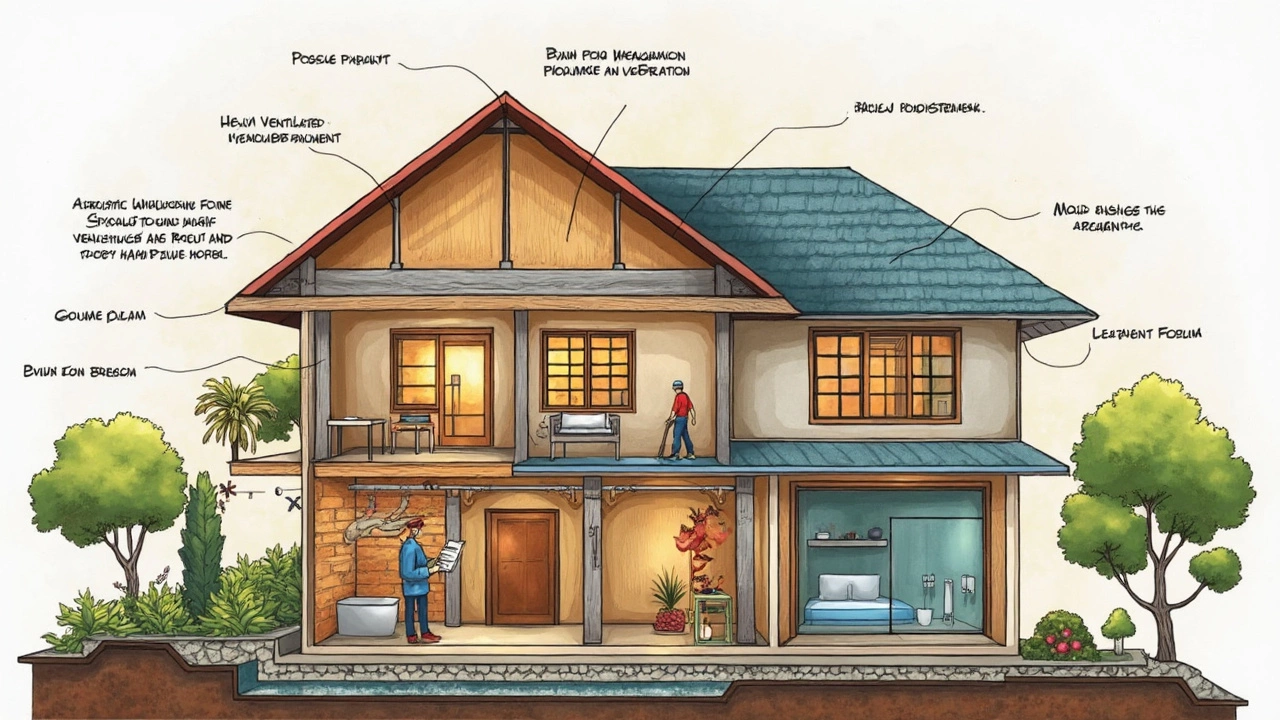Think that shiny new house you've got is mold-proof? Think again. Even fresh-off-the-market homes can attract those pesky mold spores if certain things slip through the cracks (literally and figuratively). Yes, construction techniques have come a long way, but cutting-edge doesn't mean carefree.
What really invites mold into a new build? It often starts with moisture. You know, that sneaky unwanted guest? Whether it’s because of trapped construction moisture, leaky fixtures, or poor ventilation, moisture is mold’s best buddy. And while new build designs include more safeguards than ever, they’re not entirely foolproof.
Interesting tidbit: some modern materials are like a double-edged sword. They help with energy efficiency but, weirdly enough, can create a friendlier environment for mold if not managed properly. What's the takeaway? Don't let all that newness lull you into a false sense of security. Stay clued-in on how to keep things dry and aired out. Mold prevention isn’t just a task for the owner of a 50-year-old fixer-upper.
- Understanding New Build Vulnerabilities
- Common Causes of Mold in New Builds
- The Role of Building Materials
- Effective Moisture Management
- Signs of Mold to Watch Out For
- Preventive Measures and Solutions
Understanding New Build Vulnerabilities
You’d think a brand-new house wouldn't have issues, right? But here's the kicker—even new construction isn't immune to troubles, especially when we're talking about mold. You know, that musty stuff nobody wants wandering under their roof.
So, why are new builds at risk? First off, construction moisture is a major culprit. If moisture from wet materials like plaster and concrete doesn't get a chance to dry out properly before closing everything up, it's like rolling out a welcome mat for mold.
Why Moisture Matters
Moisture is the root of most new build mold issues. Water can sneak in from various sources like rain during construction or simply not letting materials dry out. Once everything gets sealed up tight, poor ventilation can keep the moisture locked inside like a moisture trap.
The Energy Efficiency Paradox
Another thing to consider is how today's tightly sealed new buildings are designed to be energy efficient. That means good insulation and fewer leaks, but it also means that any trapped moisture doesn't have an easy way out, which can lead to mold.
Fast Construction Pace
Speed is often a factor. Builders work fast to meet deadlines, sometimes rushing through processes without giving materials proper time to dry. This can lead to issues down the line where trapped moisture turns into a mold breeding ground.
Potential Problem Areas
- Basements and crawl spaces: These areas can stay damp and are perfect for mold growth.
- Around windows and doors: Poor insulation can let condensation build up.
- Behind walls and under floors: Where ventilation is poor, moisture can settle.
Understanding these vulnerabilities is half the battle when owning a new build. The rest? Well, it's about tackling these issues head-on with some solid home maintenance and making sure any warnings signs of mold get taken care of before they spiral into a bigger problem.
Common Causes of Mold in New Builds
Even though new builds are designed to withstand modern challenges, mold can still sneak in. So, what's actually allowing this unwanted guest to crash the party?
1. Moisture from Construction
Believe it or not, new builds often have moisture leftover from the construction process itself. Wet wood, damp concrete, and unsealed areas can harbor moisture. Once sealed up, this moisture can't escape and becomes the perfect breeding ground for mold.
2. Poor Ventilation
Insulation is great for energy efficiency, but if your home can't breathe, you're asking for trouble. Inadequate ventilation in newly constructed homes can trap humid air inside, creating a cozy environment for mold to grow. Make sure you're keeping those airways clear and ventilated!
3. Water Leaks
Even the best plumbers make mistakes. New homes can have leaks from plumbing mishaps or improperly sealed windowsills and doors. These leaks let water seep in, and before you know it, you've got mold.
4. HVAC Systems
Your brand-new HVAC system might be contributing to the problem. If they're not correctly sized or maintained, they can lead to condensation and ultimately, mold. Regular checks and maintenance of these systems are crucial.
5. Environmental Factors
Depending on where you live, weather can play a major role. Heavy rainfall or humidity can exacerbate mold issues, especially if drainage systems aren't up to snuff.
| Factor | Impact |
|---|---|
| Construction Moisture | High |
| Ventilation Issues | Medium |
| Water Leaks | High |
| HVAC Errors | Medium |
| Environmental Impact | Variable |
Considering these factors during and after your build can make all the difference. It's all about keeping things dry, ventilated, and catching leaks before they turn into full-blown moldy disasters.
The Role of Building Materials
Ever wondered how the materials in your shiny new home could make or break its defense against mold? It's more interesting than you might think! New builds often use modern materials designed for energy efficiency, but some of these materials might not breathe as much as you’d hope.
Let me break it down: Certain materials, like drywall or wood, can absorb moisture, becoming prime real estate for mold if they stay wet long enough. Builders today sometimes opt for materials like fiberglass or specific types of concrete that are less likely to hold moisture. Sounds smart, right?
Commonly Used Materials
- Drywall: Popular for its clean finish but can be a mold magnet if it gets damp.
- Concrete: It's durable and less prone to moisture absorption, especially if sealed properly.
- Fiberglass: Often used for insulation, doesn’t provide food for mold.
Another trick they use is MR, or moisture-resistant, drywall. If your builder mentions using this, give them a thumbs up. It’s not completely mold-proof, but it surely ups the game.
Keep an eye on energy-efficient materials too. They’re fantastic for saving on your power bill, but their tight seals can lead to tricky ventilation situations, potentially trapping moisture if not properly managed. That's why a solid ventilation system is worth its weight in gold.
Here's an interesting snippet of info: A study in Sweden found that buildings with proper moisture control strategies and regular maintenance had 50% less mold growth compared to those without. Not too shabby, huh?
All said and done, the materials lay the foundation, but the ongoing care you give your new build determines its mold destiny.

Effective Moisture Management
Keeping your new build mold-free starts with one critical task: managing moisture. That seems like a no-brainer, right? But you’d be surprised at how often the tiniest things slip by unnoticed, turning your cozy home into mold's favorite hangout.
Keep an Eye on Humidity Levels
Trust me, a little vigilance goes a long way. Invest in a good humidity monitor to keep track of your indoor levels. Ideally, you'll want to keep it below 60%—lower is better. If you spot a number climbing too high, it’s time to take action.
Seal it Up
Waterproofing is your first line of defense. Check that window and door seals are tight, especially in rooms exposed to the elements like attics and basements. If there’s even a hint of a leak, get it sorted pronto!
Ventilation is Key
Modern energy-efficient new builds might be great for the planet, but they can also trap moisture if you're not careful. Ensure your ventilation systems are working like a charm. Consider installing exhaust fans in the kitchen and bathrooms, and use them regularly.
Landscape Wisely
Don't forget the outdoors! Proper grading directs water away from your foundation. Keep gutters clean and make sure downspouts extend far enough to channel water away.
Quick Fixes with Big Impact
- Run dehumidifiers in damp areas like basements.
- Open windows when the weather's nice to let natural air circulate.
- Fix any leaks at first sight—dripping taps and blocked drainage can quickly become a bigger problem.
- Consider moisture-resistant building materials for sensitive areas.
Sometimes it helps to know you're not alone. According to a survey from the International Association of Certified Home Inspectors, about 25% of American homes face mold issues due to poor moisture management. May as well make sure your new home isn't one of them!
Signs of Mold to Watch Out For
Recognizing mold isn’t always straightforward, especially in a new build. It can be a bit of a hide-and-seek champion, lurking in places where you least expect it. So, how do you know mold is crashing your housewarming party? Here’s what you should keep an eye on.
Unpleasant Odors
If you've noticed a musty smell wafting through your new home, consider it a red flag. Mold has a distinctive odor that resembles old, damp socks or a wet, earthy scent. Even if you can't spot mold, that smell is often an early indicator that it's nesting somewhere nearby.
Visible Spots and Patches
Don't ignore any strange discolorations on walls or ceilings. Mold usually appears as black, green, or even white fuzzy spots. In new builds, they might pop up around windows, in bathrooms, or behind appliances where moisture gathers.
Health Issues
Is someone in your household suddenly experiencing unexplained sneezing, coughing, or itchy eyes? Health symptoms like these can be mold's way of saying hello. Mold spores are notorious for causing allergic reactions and triggering asthma attacks.
"If you suspect you have mold, it's crucial to act quickly. Mold can spread rapidly and cause structural damage in addition to health risks," advises Dr. Holly Goodwin, an expert in environmental health.
Peeling Paint or Wallpaper
Mold can sometimes lead to peeling paint or wallpaper, as it weakens the surface underneath. This might look like just a cosmetic issue, but it can signal a deeper problem with moisture and potential mold growth.
Frequent Moisture or Dampness
Often in new builds, the culprits are leaks or inadequate ventilation that lead to persistent dampness. If you’re frequently mopping up water or notice condensation on your windows, it might be time to investigate further.
- Check under sinks for any leaks.
- Inspect areas around tubs and showers.
- Use a dehumidifier in consistently damp rooms.
Don’t wait until mold has overstayed its welcome. Being vigilant with these signs ensures a healthy and mold-free environment.
Preventive Measures and Solutions
Let’s face it, preventing mold requires a bit of proactive planning, but it’s totally doable. First things first, tackle humidity. Keep indoor humidity levels below 60%. Investing in a quality dehumidifier can work wonders, especially in more moisture-heavy areas like basements.
Ventilation is Key
You’ve heard it before, and it's true: proper ventilation is crucial. Make sure your home's ventilation fans—think bathrooms and kitchens—are functioning well and used regularly. If your new build came with an energy-efficient wrap, you need to be extra vigilant about airflow to prevent any moldy surprises.
Seal the Deal
Check all seals, especially around windows, doors, and in the roof. Water might find its way into the smallest cracks if these aren't sealed properly. If you’re DIY-inclined, there are plenty of waterproof sealants available that you can apply yourself.
Regular Inspection
A yearly inspection doesn’t just sound like a good idea—it is a good idea. Catching mold early saves you a heap of trouble later. Look for discolored spots and that telltale musty smell. Sometimes, a touch of proactive paranoia is a good thing!
Consider Mold-Resistant Products
If you haven’t finished construction yet or are planning a renovation, consider mold-resistant products. There’s mold-resistant drywall and paints available that can add an extra line of defense against mold.
Want a quick overview? Here are some basic actions:
- Use exhaust fans in showers and kitchens.
- Fix leaks immediately to prevent water accumulation.
- Regularly check seals and repair any damage.
- Control indoor humidity—consider smart home tech for monitoring.
- If you find mold, clean it up right away. Small patches can be treated with a simple bleach solution.
Remember, safeguarding your home against mold isn't only about avoiding unpleasant smells and appearances. It's about maintaining the health of your living space, especially in a new build. A vigilant approach can keep mold where it belongs—out of your home.


